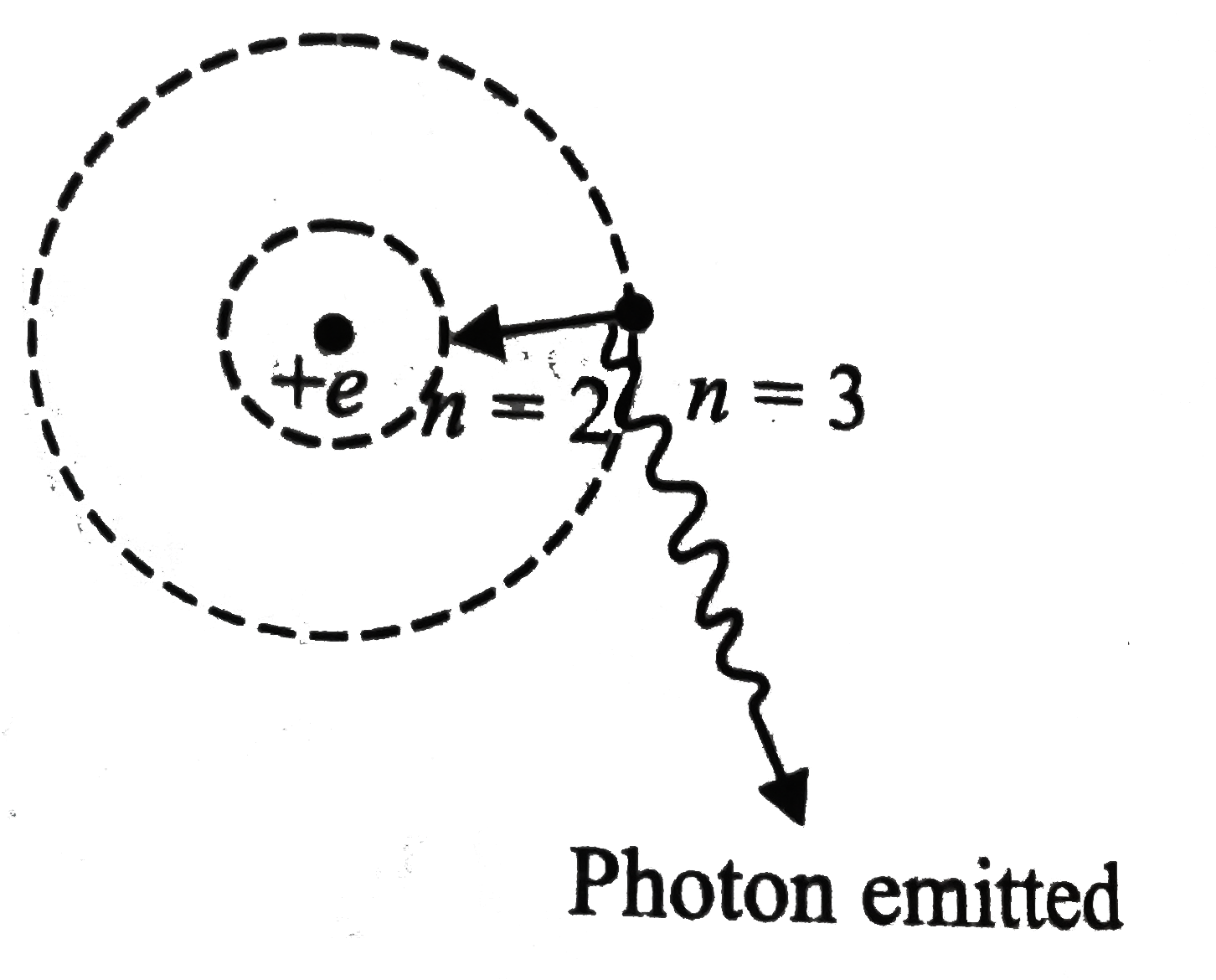A single electron orbit around a stationary nucleus of charge +Ze where Z is a constant and e is the magnitude of the electronic charge. It requires47.2eV to excite the electron from the second bohr orbit to the third bohr orbit. Find
(i) The value of Z
(ii) The energy required by nucleus to excite the electron from the third to the fourth bohr orbit
(iii) The wavelength of the electronmagnetic radiation required to remove the electron from the first bohr orbit to inlinity
(iv) The energy potential energy potential energy and the angular momentum of the electron in the first bohr orbit
(v) The radius of the first bohr orbit (The ionization energy of hydrogen atom =13.6eV bohr radius =5.3×10−11matre velocity of light =3×108m/sec planks 's constant =6.6×10−34 jules - sec )
To solve the problem step by step, we will break down each part of the question.
Given Data:
- Energy required to excite from the second to the third orbit: ΔE=47.2eV
- Ionization energy of hydrogen: E1=13.6eV
- Bohr radius: r0=5.3×10−11m
- Planck's constant: h=6.63×10−34J s
- Speed of light: c=3×108m/s
(i) Finding the value of Z
1. Energy in nth level: The energy of an electron in the nth orbit is given by:
En=−Z2⋅13.6eVn2
2. Energy difference: The energy difference between the second and third orbits is:
ΔE=E3−E2=(−Z2⋅13.632)−(−Z2⋅13.622)
ΔE=Z2⋅13.6(14−19)
ΔE=Z2⋅13.6⋅(9−436)=Z2⋅13.6⋅536
3. Setting up the equation:
47.2=Z2⋅13.6⋅536
4. Solving for Z2:
Z2=47.2⋅3613.6⋅5
Z2=1699.268≈24.99
Z≈5
(ii) Energy required to excite from the third to the fourth orbit
1. Energy difference:
ΔE=E4−E3=Z2⋅13.6(132−142)
ΔE=Z2⋅13.6(19−116)
ΔE=Z2⋅13.6⋅(16−9144)=Z2⋅13.6⋅7144
2. Substituting Z=5:
ΔE=25⋅13.6⋅7144≈16.63eV
(iii) Wavelength of radiation to remove the electron from the first orbit to infinity
1. Ionization energy:
E=−E1=Z2⋅13.6eV=25⋅13.6=340eV
2. Using the relation E=hcλ:
λ=hcE
λ=(6.63×10−34J s)(3×108m/s)340×1.6×10−19J
λ≈36.056nm
(iv) Potential energy and angular momentum in the first orbit
1. Potential energy:
U=2⋅E1=2⋅(−13.6)=−27.2eV
2. Angular momentum:
L=n⋅h2π=1⋅6.63×10−342π≈1.0546×10−34J s
(v) Radius of the first Bohr orbit
1. Using the formula for radius:
rn=n2⋅5.3×10−11Z
r1=12⋅5.3×10−115=1.06×10−11m
Summary of Results:
- (i) Z=5
- (ii) Energy from 3rd to 4th orbit: 16.63eV
- (iii) Wavelength for ionization: 36.056nm
- (iv) Potential energy: −27.2eV, Angular momentum: 1.0546×10−34J s
- (v) Radius of the first orbit: 1.06×10−11m
- Energy required to excite from the second to the third orbit: ΔE=47.2eV
- Ionization energy of hydrogen: E1=13.6eV
- Bohr radius: r0=5.3×10−11m
- Planck's constant: h=6.63×10−34J s
- Speed of light: c=3×108m/s
En=−Z2⋅13.6eVn2
ΔE=E3−E2=(−Z2⋅13.632)−(−Z2⋅13.622)
ΔE=Z2⋅13.6(14−19)
ΔE=Z2⋅13.6⋅(9−436)=Z2⋅13.6⋅536
47.2=Z2⋅13.6⋅536
Z2=47.2⋅3613.6⋅5
Z2=1699.268≈24.99
Z≈5
ΔE=E4−E3=Z2⋅13.6(132−142)
ΔE=Z2⋅13.6(19−116)
ΔE=Z2⋅13.6⋅(16−9144)=Z2⋅13.6⋅7144
ΔE=25⋅13.6⋅7144≈16.63eV
E=−E1=Z2⋅13.6eV=25⋅13.6=340eV
λ=hcE
λ=(6.63×10−34J s)(3×108m/s)340×1.6×10−19J
λ≈36.056nm
U=2⋅E1=2⋅(−13.6)=−27.2eV
L=n⋅h2π=1⋅6.63×10−342π≈1.0546×10−34J s
rn=n2⋅5.3×10−11Z
r1=12⋅5.3×10−115=1.06×10−11m
- (i) Z=5
- (ii) Energy from 3rd to 4th orbit: 16.63eV
- (iii) Wavelength for ionization: 36.056nm
- (iv) Potential energy: −27.2eV, Angular momentum: 1.0546×10−34J s
- (v) Radius of the first orbit: 1.06×10−11m
Topper's Solved these Questions
- BOOK - CENGAGE PHYSICS ENGLISHCHAPTER - ATOMIC PHYSICSEXERCISE - Exercise 4.115videos
ATOMIC PHYSICS
- BOOK - CENGAGE PHYSICS ENGLISHCHAPTER - ATOMIC PHYSICSEXERCISE - Exercise 4.212videos
ATOMIC PHYSICS
- BOOK - CENGAGE PHYSICS ENGLISHCHAPTER - ATOMIC PHYSICSEXERCISE - ddp.4.315videos
ATOMIC PHYSICS
- BOOK - CENGAGE PHYSICS ENGLISHCHAPTER - ALTERNATING CURRENTEXERCISE - Single Correct10videos
ALTERNATING CURRENT
- BOOK - CENGAGE PHYSICS ENGLISHCHAPTER - CAPACITOR AND CAPACITANCEEXERCISE - Integer5videos
CAPACITOR AND CAPACITANCE
Similar Questions
A single electron orbits around a stationary nucless of charge +Ze where Z is a constant and e is the magnitude of electronic charge ,if respuires 47.2 e

is excite the electron from the second bohr orbit to the third bohr orbit
a. Find the value of ZView SolutionA single electron orbits around a stationary nucleus of charge +Ze, where Z is a constant and e is the electronic charge. It requires 47.2eV to excited the electron from the second Bohr orbit to the third Bohr orbit. Find (i) the value of Z, (ii) the energy required to excite the electron from the third to the fourth Bohr orbit and (iii) the wavelength of the electromagnetic radiation radiation to remove the electron from the first Bohr orbit to infinity.
View Solution
Knowledge Check
- Question 1 - Select One
The de-Broglie wavelength of an electron in the first Bohr orbit is
Aequal to one- fourth the circumference of the first orbitBequal to half the circumference of first orbitCequal to twice the circumference of first orbit.Dequal to the circumference of the first orbit.
A single electron orbits a stationary nucleus of charge +Ze, where Z is a constant and e is the magnitude of electronic charge . It requires 47.2eV to excite electron from second Bohr orbit to third Bhor orbit . Find
a the value of Z
b the energy required to excite the electron from the third to the fourth Bohr orbit.
c. the wavelength of electromagnetic rediation required to remove the electron from the first Bohr orbit to infinity.
d Find the KE,PE, and angular momentum of electron in the first Bohr orbit.
e. the redius of the first Bohr orbit
[The ionization energy of hydrogen atom =13.6eV Bohr radius =5.3×10_11m, "velocity of light" =3×10−8jms−1, Planck's constant =6.6×10−34j−s]View SolutionCalculate angular momentum of an electron in the third Bohr orbit of hydrogen atom.
View SolutionAccording to Bohr's theory the angular momentum of an electron in the fourth orbit is
View SolutionA single electron ion has nuclear chrage +Ze where Z is atomic number and e is electronic charge. It requires 16.52eV to excite the electron from the second Bohr orbit to third Bohr orbit. Find
(a) The atomic number of element?
(b) The energy required for transition of electron from first to third orbit?
(c ) Wavelength of photon required to remove electron from first Bohr orbit to infinity?
(d) The kinetic energy of electron on first Bohr orbit?View SolutionAccording to Bohr's theory, the angular momentum of electron in the fifth Bohr orbit is:
View SolutionThe ratio of the energy required to remove an electron from the first three Bohr's orbit of Hydrogen atom is
View SolutionThe value of orbit angular momentum of an electron in the 3rd Bohr orbit of hydrogen will be
View Solution

